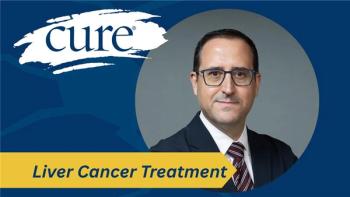Patients with advanced urothelial carcinoma, a type of bladder cancer, some of whom were ineligible for cisplatin, who were treated with frontline Keytruda (pembrolizumab) and Cabometyx (cabozantinib) responded to treatment with a manageable side effect profile, recent study results demonstrated.
These findings from the phase 2 PemCab trial were presented at the 2024 Genitourinary Cancers Symposium.
The doublet elicited an objective response rate (the percentage of patients with a complete or partial response to treatment) of 45.7% in evaluable patients (36 patients), which was comprised of a complete response (disappearance of all signs of cancer from treatment) rate of 14.2% and a partial response (decrease in tumor size or extent of cancer in the body from treatment) rate of 31.4%; 25.7% of patients had a best response of stable disease (cancer that is neither increasing or decreasing in severity or extent), 28.5% experienced disease progression (cancer that continues to spread or grow) and one patient was not evaluable. The clinical benefit rate (percentage of patients who achieve partial remission, partial remission or stable disease for six months) was 71.4% with the regimen, and 80% of patients experienced tumor shrinkage.
- A combination treatment using Keytruda (pembrolizumab) and Cabometyx (cabozantinib) has shown effectiveness and manageable side effects for patients with advanced urothelial carcinoma, even for those ineligible for cisplatin treatment.
- The treatment resulted in a positive response rate, with a substantial number of patients experiencing either complete disappearance or a significant reduction in their disease.
- Patients receiving Keytruda and Cabometyx experienced tumor shrinkage, and the median duration of response was notable, suggesting a meaningful impact on controlling the progression of the disease.
- The study addressed an unmet need for patients with limited therapeutic options, especially those ineligible for cisplatin, providing a potential alternative with manageable side effects and promising efficacy.
The median time to response was 2.7 months, and at a median follow-up of 20.2 months, the median duration of response (the time from treatment assignment until progression or death in those who achieved a partial or complete response) was 14.7 months. As of their last follow-up in the clinic, eight patients were still responding to treatment. At a median follow-up of 14.3 months, the median progression-free survival (the time during and after treatment when a patient lives with the disease without worsening) was 7.6 months, and the median overall survival (the time from the start of treatment when a patient with cancer is still alive) was 17.1 months.
“In this hard-to-treat population consisting of cisplatin-ineligible with high PD-L1 score (meaning they are eligible for immunotherapy), cisplatin-refusing and platinum-ineligible patients (with urothelial carcinoma, Cabometyx) plus (Keytruda) showed encouraging efficacy,” said Dr. Rohit K. Jain, assistant member in the Department of Genitourinary Oncology at Moffitt Cancer Center in Tampa, Florida, in a presentation of the data.
There are limited therapeutic options available to patients with cisplatin- and platinum-ineligible locally advanced or metastatic urothelial carcinoma, underscoring an area of unmet need. VEGFR TKIs like Cabometyx, Votrient (pazopanib) and Sutent (sunitinib) have exhibited response rates ranging from 7% to 19% in patients with pretreated metastatic urothelial carcinoma, according to Jain. He added that although phase 3 trial data have indicated that regimens like Avastin (bevacizumab) paired with cisplatin and gemcitabine and Cyramza (ramucirumab) plus docetaxel can prolong progression-free survival, they have not led to significant improvements in overall survival.
The study enrolled patients with locally advanced or metastatic urothelial carcinoma who had an ECOG performance status of 0 to 2 (meaning patients who were either fully active up to being restricted in work activity but able to perform self-care tasks) and a measurable target lesion. Patients also needed to have cisplatin-ineligible disease.
Study participants were given Keytruda every 3 weeks plus daily Cabometyx until disease progression, intolerable side effects or for up to two years.
The main focus of the study was to assess the objective response rate, with other areas including progression-free survival, overall survival, duration of response, disease control rate (patients with partial response, complete response or stable disease from treatment) and safety.
Between December 2018 and April 2023, a total of 36 patients were enrolled in the phase 2 study. The median patient age was 72.5 years, and most patients were male (77.8%). Regarding primary tumor location, 52.8% had upper tract disease and 47.2% had disease in the bladder.
At the time of data cutoff in November 2023, one patient was still on treatment. The most common reason for discontinuation was radiological or clinical disease progression (50%), followed by side effects (22.2%), patient decision (13.8%), death because of disease progression (5.5%) and treatment completion (5.5%). The median number of cycles of Keytruda and Cabometyx received was 10 and 7.5, respectively.
No new safety signals were observed with the doublet. Most patients (91.6%) experienced at least one treatment-emergent side effect and 50% had side effects that were severe or worse. Two instances of life-threatening side effects related to Cabometyx were observed; these effects included gastrointestinal bleeding and colonic perforation (a hole in the wall of the colon or small intestine). Moreover, 83% of patients had immune-related side effects with 11% needing high-dose steroids. There were no treatment-related deaths.
Cabometyx dose interruptions and reductions were needed in 47.2% and 33.3% of patients, respectively; 16.6% of patients discontinued the agent.
The most common treatment-emergent side effects reported with Cabometyx plus Keytruda were fatigue (any severity, 63.9%; severe or worse, 2.8%), diarrhea (58.3%; 2.8%), palmar-plantar erythrodysesthesia syndrome (also known as hand-foot syndrome when patients develop swelling, redness and pain on their hands and feet; 41.7%; 5.6%), itching (38.9%; 0%), anorexia (33.3%; 5.6%), nausea (33.3%; 2.8%), low phosphate levels in the blood (27.8%; 0%), low magnesium levels in blood (25%; 0%), hypothyroidism (underactive thyroid; 25%; 0%), oral mucositis (irritation and tissue swelling in the mouth; 25%; 2.8%), vomiting (25%; 0%), hoarseness (22.2%; 0%), elevated protein in the urine (13.9%; 5.6%) and a thromboembolic event (related to blood clots; 8.3%; 8.3%).
For more news on cancer updates, research and education, don’t forget to subscribe to CURE®’s newsletters here.






